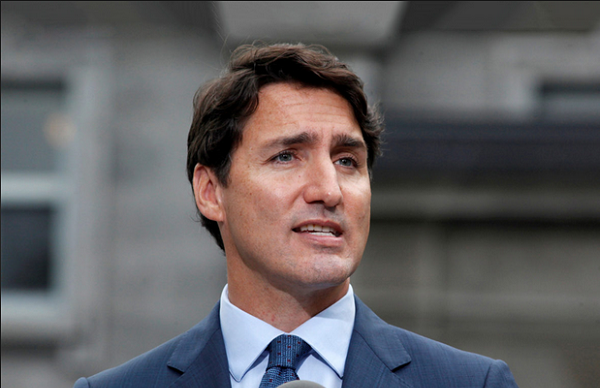President Trump draws up reciprocal tariffs for a global trade war, including Canada
U.S. President Donald Trump has asked his administration to draw up a list of reciprocal tariffs for every country, including Canada, that it believes is imposing unfair duties, trade barriers or taxes on American imports – a threatened punitive measure from the White House that could be implemented within weeks.
This latest announcement forms part of Mr. Trump’s continuing campaign against what he considers unfair treatment from trading partners such as China, India, the European Union, Canada and Mexico.
These countertariffs would be intended as retaliation for trade barriers imposed on the U.S. by other countries. Details are yet to come, but experts say possible Canadian targets could include the federal digital services tax, the goods and services tax and even this country’s sheltered dairy, egg and poultry industries.
Separately, Mr. Trump said tariffs on foreign-assembled automobiles are “coming soon.” Earlier this week he told Fox News he was considering a levy on Canadian-made cars of as much as 50 to 100 per cent. “If we don’t make a deal with Canada, we’re going to put a big tariff on cars. Could be a 50 or 100 per cent because we don’t want their cars,” he said.Mr. Trump singled out Canada three times in comments to reporters in the Oval Office Thursday.
“Canada’s been very bad to us on trade but now Canada is going to have to start paying up,” Mr. Trump said as he announced an executive order directing the Secretary of Commerce and United States Trade Representative to examine trading relationships with other countries, identify what they consider unfair levies or barriers on Americans and propose remedies.
“Canada is going to be a very interesting situation because, you know, we just don’t need their product.”
He made another pitch for Canada to agree to annexation by the United States to avoid tariffs and referred to Prime Minister Justin Trudeau as “Governor” Trudeau. “I think Canada is going to be a very serious contender to be our 51st state.”
The U.S. President also repeated criticism of Canada for its failure to meet the NATO military alliance defence spending target of 2 per cent of gross domestic product. “They have a very low military cost. They think we’re going to, you know, protect them with our military, which is unfair,” he said of Canada. He suggested Canada cannot afford to meet its required level of military spending. “If they had to pay just something modestly fair, they wouldn’t be able to succeed as a country. And that’s why, that’s why I feel they have to become a state.”
Canada has pledged to hit the 2-per-cent target in 2032 although federal officials have said this could be expedited.
These new reciprocal tariffs would be separate from other levies Mr. Trump has threatened or already imposed on Canadian goods, including a 25-per-cent tax on steel and aluminum imports set to start March 12. The U.S. President is still holding the threat of across-the-board tariffs of 25 per cent on most goods, and 10 per cent on energy and critical minerals, over allegations Canada is failing to secure the shared border from “illegal migration” and smuggling of the opioid fentanyl into American territory.
The White House mentioned the 3-per-cent digital sales tax imposed by Canada in a fact sheet released Thursday. “Canada and France use these taxes to each collect over $500-million per year from American companies,” it said of the levy Ottawa applies to digital services exceeding $20-million earned in Canada by companies with at least $1.1-billion in global revenue. This affects large digital service providers such as Amazon, Google, Netflix and Spotify.
Howard Lutnick, Trump’s pick for commerce secretary, said the administration would address each affected country one by one and that studies on the issue would be completed by April 1, according to Reuters.
A spokesman for federal Finance Minister Dominic LeBlanc, said Ottawa is still reviewing Mr. Trump’s statement, but that U.S. tariffs on Canadian goods would chiefly hurt Americans.
“Our government strongly believes that Canada’s decades-long partnership with the United States is mutually beneficial – and that tariffs on Canadian exports to the United States would be harmful first and foremost to American consumers,” Gabriel Brunet, press secretary to Mr. LeBlanc, said in a statement.
Daniel Ujczo, an Ohio trade lawyer who represents businesses on both sides of the border, said all U.S. trade grievances are on the table for reciprocal tariffs.
“It doesn’t appear Canada is getting a pass for anything,” he said.
He said Canada should consider Thursday’s announcement and other tariff threats or measures announced by Mr. Trump as a prelude to the coming renegotiations of the United States-Mexico-Canada Agreement. The trade deal, originally negotiated by Mr. Trump, is up for renewal in 2026 but the Trump administration has signalled it wants to start negotiations early.
The General Agreement on Trade and Tariffs and later the World Trade Organization that replaced it managed to lower tariffs among most countries. But many still reserve the right to impose higher tariffs or other types of barriers on some imports to serve national interests. Canada, for instance, uses prohibitively steep tariffs to protect its dairy, egg and poultry industries under a system called supply management.
Mr. Trump’s reciprocal tariff instructions would give Washington the right to impose countertariffs for a wide variety of policies by trading partners including “any government-imposed measure or policy or nonmonetary barrier that restricts, prevents, or impedes international trade in goods, including import policies, sanitary and phytosanitary measures, technical barriers to trade, government procurement, export subsidies, lack of intellectual property protection, digital trade barriers, and government-tolerated anticompetitive conduct of state-owned or private firms.”
International trade lawyer Lawrence Herman said this broad list of U.S. grievances is written in such a way it could even encompass requiring U.S. companies to translate labels or instructions into French.
Canadian Chamber of Commerce president Candace Laing urged Canada to repeal its digital services tax, which she called an unnecessary trade irritant.
She said however Canada needs to steer conversations about its trading practices into a formal USCMA renegotiation. “I think we have to be ready for more pressure and disruption but also really smart about this. Because his playbook is he’ll push, push, push,” she said. “Let’s work this out in real negotiations not this ad hoc process.”
In addition to tariffs imposed by trading partners, Mr. Trump’s memorandum takes aim at other policies that his administration calls discriminatory against the U.S., including value-added taxes.
BMO chief economist Douglas Porter said most countries impose a form of a value-added tax, which is a consumption tax on goods and services. In Canada, the federal government imposes a 5-per-cent goods and services tax, while most provinces have their own sales taxes as well.
“If this is the approach the administration is going to take, then a lot of countries should be concerned here,” Mr. Porter said in an interview.
Paul Ashworth, chief North America economist at Capital Economics, called the decision to go after value-added taxes “strange,” given these taxes are imposed on all goods and services, regardless of where they come from.
It’s still unclear how the U.S. administration plans to calculate reciprocal tariffs, making it challenging to assess the potential impact on Canada. However, Mr. Ashworth’s calculations suggest if the Trump administration were to place reciprocal levies equal to value-added taxes and tariffs imposed on U.S. goods, Canada could face a 19-per-cent tariff.
That figure doesn’t include any retaliation against Canada’s digital services tax imposed on tech giants, which the Trump administration singled out as discriminatory against U.S. companies.
Given how complex it would be for the U.S. to calculate reciprocal tariffs for each country – while taking non-tariff measures into account – Mr. Porter said the U.S. could decide to impose universal tariffs instead.
“This really is more than just bluster,” he said, adding that the memo is the latest move from the Trump administration that suggests it’s serious about imposing tariffs.
Mr. Trump’s planned reciprocal tariffs fulfil a campaign pledge he made to retaliate against countries that place higher tariffs, and other forms of duties and taxes, on U.S. imports than the United States does on their imports.
The United States generally imposes low tariffs on imports from developing countries.
This article was first reported by The Globe and Mail













